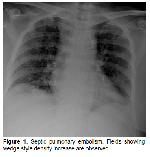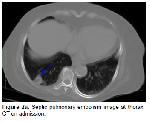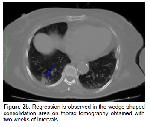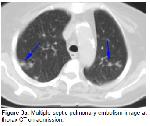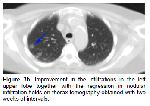SPE is an uncommon disorder that generally presents with an insidious onset of fever, respiratory symptoms and lung infiltrates. Clinical and radiologic features at presentation are usually nonspecific, and the diagnosis of this disorder is frequently delayed
1-5.
The most common causes for SPE include intravenous drug use, infective endocarditis of the tricuspid valve, septic thrombophlebitis, suppurative angina, periodontal abscess, purulent infection of skin and soft tissues, pelvic thrombophlebitis, intravascular catheters, pacemakers, liver abscess and hemodialysis2.
In SPE, the embolic blood clot that leads to an infarction in the pulmonary vasculature also contains microorganisms that incite a focal abscess. Chest radiography may reveal poorly marginated peripheral lung nodules that cause a tendency to cavitate but are more often nonspecific in appearance. CT of the thorax can be more helpful in demonstrating peripheral cavitary lesions2.
Many risk factors have been discovered in the pathogenesis of fungal infections. Being aware of the risk factors and being careful in risky patients is important for the clinicians in the diagnosis of fungal invasion. These risk factors include disease severity (being on a ventilator for longer than 48 hours), wide spectrum antibiotic use, presence of an intravenous catheter, malnutrition, immunosupression and burns4,5. Our patient was in high risk groups as she underwent an operation due to intracerebral hematoma, having diabetes, being followed up in intensive care units, using wide spectrum antibiotics.
Candidal identification is required phenotypical and genotypical tests. Samples which were collected from clinical specimens, identified by using physiological and morphological tests, including some of the following: morphology on a cornmeal agar, assimilation of sugars in commercial kits, fermentation of several carbon sources, growth on nitrogen sources, growth at various temperatures, and ability to hydrolyze urea. Now these phenotypical and morphological determinations can be offered by automated systems. For molecular identification, genomic DNA was made right away from a single yeast colony7.
In a serial composed of 17 SPE cases published by Carriago et al8, fever was the most common symptom (88%) followed by chest pain and cough. Fever was in the foreground also in our patient. Okada et al.9 has been reported a case report related to septic pulmonary emboli caused by urinary tract infection.
In a study of Sakuma et al.10 from Japan, they stated that the fungal embolism incidence is higher than bacterial agents in case of presence of an underlying risk factor. Our patient had the risk factors like presence of diabetes, intensive care unit stay, antibiotic use.
Takahasi et al.11 reported an SPE case caused by C. albicans in a patient who was immunocompromised due to continuing bladder cancer.
Diagnosis may frequently hold up due to nonspecific clinical and radiological features. SPE should be suspected in high-risk patients with a history of intravenous drug use or underlying disease, if they have fever, dyspnea, chest pain and other clinical manifestations and their lung images suggest multiple nodules or plaques with or without pleural effusion. Enhanced chest CT examination should be done to identify the emboli and blood culture, liver ultrasound, echocardiography and other tests should be performed to find the origin of the emboli12.
The prediagnosis of septic pulmonary embolism should be restrained in mind in patients who have fever, bilateral peripheral infiltrates on chest x-ray, whose clinical condition gradually deteriorates, differential diagnoses should be omitted and the principal focus should be investigated.
The primary treatment is antimicrobial chemotherapy and removal of the infected source. In our patient, CT revealed specific findings such as multiple nodular lesions, feeding-vessel sign, cavitation of nodules, and pleural effusion. Candida superinfection of the thrombus can occur, especially in patients on long-term antibiotic therapy and on parenteral nutrition. Removal of the catheter, thrombolytic therapy, anticoagulation, and antifungal therapy will usually eradicate the candidemia and restore venous patency13.
Candida ciferrii is a newer strain of Candida, which has been seldom described as a case of human infection. All the same, in immunocompromised host it can cause human infection5.
In conclusion; although the pathogens of SPE may differ depending on the primary focus of the infection, early diagnosis and prompt antimicrobial therapy with radiologic or surgical intervention can lead to a successful treatment outcome.



